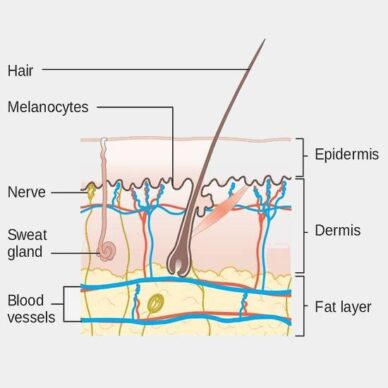Unwanted Change
Our skin brings benefits, dispelling waste products through sweat and turning sunlight into vitamin D. The downside is that too much exposure to the sun can have a negative effect, making internal cells cancerous.
Our epidermis mainly consists of cells called keratinocytes, including a layer known as basal cells. They help to produce normal skin and DNA mutations within them produce the most common form of skin cancer, basal cell carcinoma.
Other keratinocytes called squamous cells are there to strengthen and replenish the skin but can also be a point of weakness. The next most common type of skin cancer, squamous cell carinoma, develops in these cells.
In the deeper layers of the epidermis, on top of the dermis, is a range of cells called melanocytes. They produce melanin, which gives colour to our skin but are again liable to unwanted sun damage and the arrival of melanoma.
Whilst individual risk factors vary, none of us are exempt from skin cancer. Unrepaired DNA damage to skin cells is common, causing genetic defects, rapid cell multiplication and potentially tumours.
Medical Outline
Skin cells normally contain DNA repair enzymes, to help reverse UV damage. A few people lack the genes for these enzymes and can suffer higher rates of skin cancer, although this does not mean any of us are immune.
The same would apply to having lighter skin, or atypical moles. They are indicators for a higher rate but skin cancer can come regardless of colour, age, gender, or predisposition, with sun exposure a significant factor.
The ability of different types to spread and cause deeper damage varies. Basal cell carcinoma is the least likely, squamous cell carinoma more so and melanoma the most dangerous but all can bring unwanted symptoms.
Alongside the risk is good news. Diagnosis and treatment of skin cancers have advanced significantly, cure rates for most types are approaching 100% with good support and early detection.
Maxillofacial Support
We can all help ourselves, by checking our skin regularly, using sun protection, avoiding sunbeds and seeing a doctor when there’s a problem. There will still be times when skin cancer occurs, especially in facial areas.
The skin on your face is quite thin compared with other areas, yet is often the most exposed to the sun. Facial skin also sits on key areas for eating, breathing, for your senses, for living life.
Specialist maxillofacial care ensures these aspects are taken into account and as importantly, brings dedicated knowledge for diagnosis, or treatment.
Treating skin cancers on your face, lips, eyelids, or other delicate areas requires a comprehensive approach. To bring a cure, carefully consider cosmetic outcome and understand how the condition makes you feel.
Remembering that cancer care is about people and their lives matters. By all means read more on the way we approach skin cancer treatment, or contact our friendly staff.

